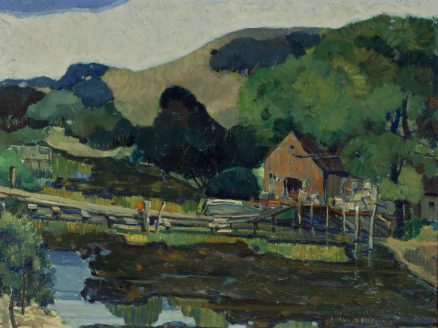- Categories
- Landscapes
- Zoom in on Artwork
- Print Page
- Email Page to Friend
A fishing shack nestled under trees against a backdrop of rolling hills forms the subject of this landscape painting by Anthony Angarola. In the middle distance, a plank footbridge crosses water whose glassy surface reflects the dark masses of trees under a placid sky. As he often did in his paintings, here Angarola used touches of bright orange—in the weathered surface of the building, in the shirt of a figure seated on the bridge, and among the dark trees on the height of the distant hill—to accentuate the rich green and blue tones that dominate the composition. An impression of deeply receding space vies with an insistence on the two-dimensionality of the painting surface, particularly in the textured brushwork and the rendering of trees, hills, and other forms as discrete blocky masses of color. As a writer for the magazine The Arts observed in 1922, “Angarola is not eminently an outdoor painter; his feeling for arrangement, for modulation of tone, is too dominating for that.”i He frankly distorted the topography he painted for the sake of formal design, insisting that the artist envisions and creates a new and different world than the reality a photograph records.
A child of immigrants, Angarola used his art to explore American identity as informed by his personal bicultural experience. In his images of the marginal world of immigrants and social misfits, distinctly American locales are important settings. He also treated more conventional rural and natural landscape subjects he found both in the Midwest and in Europe. “His most characteristic work seems to be in landscape,” according to one assessment.ii This painting, whose original title is unknown, combines the artist’s characteristic expressive manipulation of form and pigment with a lyrical take on rustic life that hints at nostalgia, in keeping with the tenor of the so-called American Scene painting that emerged near the close of Angarola’s all-too-short career. It fixes the American landscape into placid stasis, bearing witness to what a contemporary described as the artist’s “gentle, meditative, and compelling spirit.”iii
Wendy Greenhouse, PhD
Donated by M. Christine Schwartz to the Illinois State Museum, Springfield, Illinois, in 2021
i Hi Simons, “At Chicago,” The Arts 2 (Feb. 1922): 288.
ii Undated typescript “The Art of Anthony Angarola (Special Exhibition Circulated by the Art Institute of Chicago)” [possibly the Angarola solo exhibition at the Brooks Memorial Art Gallery, 1928, and Indianapolis Museum of Art, 1929], in Anthony Angarola pamphlet file, Ryerson and Burnham Libraries, Art Institute of Chicago.
iii Bernard Teevan, “Angarola’s Meditative Art,” International Studio 81 (Sept. 1925): 70.
